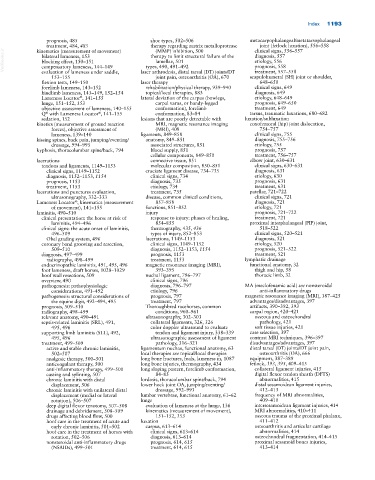Page 1227 - Adams and Stashak's Lameness in Horses, 7th Edition
P. 1227
Index 1193
prognosis, 485 shoe types, 502–506 metacarpophalangeal/metatarsophalangeal
joint (fetlock luxation), 556–558
treatment, 484, 485 therapy regarding matrix metalloprotease clinical signs, 556–557
VetBooks.ir bilateral lameness, 153 types, 490, 491–492 diagnosis, 557
(MMP) inhibition, 500
kinematics (measurement of movement)
therapy to limit structural failure of the
blocking effect, 150–151
lamellae, 501
etiology, 556
prognosis, 558
compensatory lameness, 144–149
treatment, 557–558
evaluation of lameness under saddle,
joint pain, osteoarthritis (OA), 670
153–155 laser arthrodesis, distal tarsal (DT) joints/DT scapulohumeral (SH) joint or shoulder,
flexion tests, 149–150 laser therapy 648–650
forelimb lameness, 143–152 rehabilitation/physical therapy, 939–940 clinical signs, 649
hindlimb lameness, 143–149, 152–154 topical/local therapies, 883 diagnosis, 649
®
Lameness Locator , 141–155 lateral deviation of the carpus (bowlegs, etiology, 648–649
lunge, 151–152, 153 carpal varus, or bandy‐legged prognosis, 649–650
objective assessment of lameness, 140–155 conformation), forelimb treatment, 649
Q with Lameness Locator , 141–155 conformation, 83–84 tarsus, traumatic luxations, 680–682
®
®
sedation, 152 lesions that are poorly detectable with luxation/subluxation
kinetics (measurement of ground reaction MRI, magnetic resonance imaging coxofemoral (hip) joint dislocation,
forces), objective assessment of (MRI), 408 754–757
lameness, 139–140 ligaments, 849–858 clinical signs, 755
kissing spines, back pain, jumping/eventing/ anatomy, 849–851 diagnosis, 755–756
dressage, 994–995 associated structures, 851 etiology, 755
kyphosis, thoracolumbar spine/back, 794 blood supply, 851 prognosis, 757
cellular components, 849–850 treatment, 756–757
lacerations connective tissue, 851 elbow joint, 630–631
tendons and ligaments, 1149–1153 molecular composition, 850–851 clinical signs, 630–631
clinical signs, 1149–1152 cruciate ligament disease, 734–735 diagnosis, 631
diagnosis, 1152–1153, 1154 clinical signs, 734 etiology, 630
prognosis, 1153 diagnosis, 735 prognosis, 631
treatment, 1153 etiology, 734 treatment, 631
lacerations and punctures evaluation, treatment, 735 patellar, 721–722
ultrasonography, 332–333 disease, common clinical conditions, clinical signs, 721
®
Lameness Locator , kinematics (measurement 857–858 diagnosis, 721
of movement), 141–155 functions, 851–852 etiology, 721
laminitis, 490–510 injury prognosis, 721–722
clinical presentation: the horse at risk of response to injury: phases of healing, treatment, 721
laminitis, 494–496 854–855 proximal interphalangeal (PIP) joint,
clinical signs: the acute onset of laminitis, thermography, 435, 436 518–522
496–509 types of injury, 852–853 clinical signs, 520–521
Obel grading system, 496 lacerations, 1149–1153 diagnosis, 521
coronary band grooving and resection, clinical signs, 1149–1152 etiology, 520
509–510 diagnosis, 1152–1153, 1154 prognosis, 521–522
diagnosis, 497–499 prognosis, 1153 treatment, 521
radiography, 498–499 treatment, 1153 lymphatic drainage
endocrinopathic laminitis, 491, 495, 496 magnetic resonance imaging (MRI), functional anatomy, 32
foot lameness, draft horses, 1028–1029 393–395 thigh and hip, 58
hoof wall resections, 509 nuchal ligament, 796–797 thoracic limb, 32
overview, 490 clinical signs, 796
pathogenesis: pathophysiologic diagnosis, 796–797 MA (meclofenamic acid) see nonsteroidal
considerations, 491–492 etiology, 796 anti‐inflammatory drugs
pathogenesis: structural considerations of prognosis, 797 magnetic resonance imaging (MRI), 387–425
the equine digit, 492–494, 495 treatment, 797 advantages/disadvantages, 397
prognosis, 509–510 Thoroughbred racehorses, common artifacts, 390–392, 393
radiography, 498–499 conditions, 960–961 carpal region, 420–421
relevant anatomy, 490–491 ultrasonography, 302–303 osseous and osteochondral
sepsis‐related laminitis (SRL), 491, collateral ligaments, 326, 326 pathology, 421
495, 496 color doppler ultrasound to evaluate soft tissue injuries, 421
supporting limb laminitis (SLL), 492, tendon and ligament injury, 338–339 case selection, 397
495, 496 ultrasonographic assessment of ligament contrast MRI techniques, 396–397
treatment, 499–509 pathology, 316–321 disadvantages/advantages, 397
active and stable chronic laminitis, ligamentum nuchae, functional anatomy, 63 distal tarsal (DT) joints/DT joint pain,
502–507 local therapies see topical/local therapies osteoarthritis (OA), 666
analgesic therapy, 500–501 long bone fractures, foals, lameness in, 1087 equipment, 387–389
anticoagulant therapy, 500 long bone injuries, thermography, 434 fetlock, 393, 395, 409–415
anti‐inflammatory therapy, 499–500 long sloping pastern, forelimb conformation, collateral ligament injuries, 415
casting and splinting, 507 84–85 digital flexor tendon sheath (DFTS)
chronic laminitis with distal lordosis, thoracolumbar spine/back, 794 abnormalities, 415
displacement, 506 lower hock joint OA, jumping/eventing/ distal sesamoidean ligament injuries,
chronic laminitis with unilateral distal dressage, 992–993 412–413
displacement (medial or lateral lumbar vertebrae, functional anatomy, 61–62 frequency of MRI abnormalities,
rotation), 506–507 lunge 409–410
deep digital flexor tenotomy, 507–508 evaluation of lameness at the lunge, 136 intersesamoidean ligament injuries, 414
drainage and debridement, 508–509 kinematics (measurement of movement), MRI abnormalities, 410–411
drugs affecting blood flow, 500 151–152, 153 osseous trauma of the proximal phalanx,
hoof care in the treatment of acute and luxation 411–412
early chronic laminitis, 501–502 carpus, 613–614 osteoarthritis and articular cartilage
hoof care in the treatment of horses with clinical signs, 613–614 abnormalities, 414
rotation, 502–506 diagnosis, 613–614 osteochondral fragmentation, 414–415
nonsteroidal anti‐inflammatory drugs prognosis, 614, 615 proximal sesamoid bones injuries,
(NSAIDs), 499–501 treatment, 614, 615 413–414

